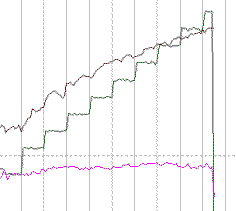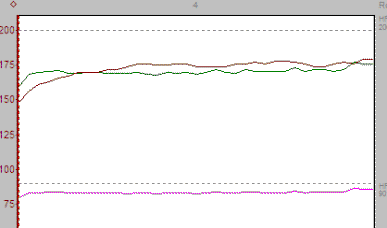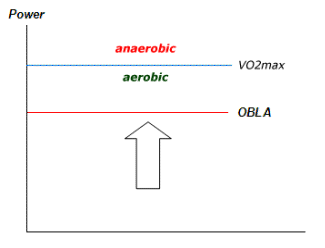Now we're in to the big scary world of smoke and mirrors! Whether you know it or not, Functional Threshold Power (FTP) is one of the key factors of your cycling armoury. But don't worry if you don't know what it is or why it should be important to you, you're not alone.
Functional Threshold Power is a phrase that has as many perceived meanings as there are gears on a bike. In this article we'll try to explain, what it is, why you should be interested in it and how you can go about understanding, measuring and improving it, to enable you to be a fitter, faster, stronger cyclist.
Before we start, a reality check. Whole books have been written on this subject, so we're not going to cover every nuance, or better still overcomplicate things, in a simple, one page article. I'll try to make this factsheet deep enough to portray a meaningful representation of the subject but not that deep as we end up drowning in science and psycho-babble. So here goes...
The General Consensus
It's generally agreed that your Functional Threshold Power is the maximal power output you can sustain for the duration of one hour. It's NOT your "average" power. As average has a different meaning in a power context to "sustained".
There are many ways to compute, extrapolate or test for Functional Threshold Power and Dr Andrew Coggan seems to be the man with a plan when it comes to this area of cycling science. So who am I to contradict. Most of this article will be a reflection of the work of himself and others, with punditry and anecdotal insight from myself!
Your Starter for Ten...
Calculating your FTP is quite straightforward. If you've got power meter analysis software (WKO+ see sidebar on the right) you can use your race and training data to accurately estimate your FTP through the Normalised Power function at the 60 minutes axis point. If you're unsure just email me and I'll send you a link.
 You could do a Ramp Test, a profile of which is seen here, and extrapolate the figures you need from its results. The final 60 seconds of sustained power are computed and approximately 75% of that gives you your FTP.
You could do a Ramp Test, a profile of which is seen here, and extrapolate the figures you need from its results. The final 60 seconds of sustained power are computed and approximately 75% of that gives you your FTP.
An alternative is to carry out a six minute wVO2max Test and extrapolate your figures, from that. There is also a 20 minute test for slightly more accurate results or you could go the whole hog and do a one hour test (a 25 mile/40k TT) and get pretty much 100% accurate results from that.
You can also compute your FTP from your lactate threshold as the two are very closely related. They're not the same but they are near neighbours in the world of FTP figures.
So loads of ways to calculate it so there's no excuses for not having a ball park figure! You can even do it with heart rate alone, you don't need a power meter, although strictly speaking you obviously won't actually have your functional threshold power figures!

If you're anything like me (an accomplished slacker) you'll find it very difficult to concentrate for a full 60 minutes, especially when it starts hurting and there's no one to talk to. So a 20 minute test (shown above) is a good a way as any of getting some scores on the doors.
Crack out a full on 20 minute ride (a 10 mile TT), grab your normalised power figure, and you've got 105% of your functional threshold. It's not as accurate as a full hour test, but it's less stressful, easier to fit in to a busy schedule, and as close as we need to be for the level of racing and training we undertake. Remember, this site is written for people who live in the real world!
Realising your potential
Okay, now we've got a figure for our functional threshold what do we do with it? Functional threshold development is all about making our athletic engine more efficient.
As a competitive cyclist, raising FTP should be your primary objective. We need to become more efficient at making use of our overall effectiveness. Here I'll explain why.
Two riders can have exactly the same relative VO2max, but it will be the one with a higher Functional Threshold Power that prevails come judgement day; or the Island Championships as they're known in Jersey.
Two club riders may turn out exactly the same power over the course of an hour. They're physical attributes, heart volume and lung capacity, may differ so their heart rates could be miles apart. The power outputs and the lines on the wattage graph may be the same but their physiological response, sensations and emotions most definitely won't!
There's more to this game than just high power figures.
Not big and not clever
Power meter users often try to hit the big maximal power numbers to reflect the measure of their prowess on the bike. Mines bigger than yours type of thing.
I'm sorry to have to disappoint our macho men, but it's the biggest FTP that's going to do the damage when it matters not maximal power output. You may have a 1000 watt sprint but if you've only got a 200 watt FTP then you ain't going to be around at the end of the race to show everyone what a sprint god you are.
I've tested some phenomenally strong riders in the lab that would be dropped before they got to the first hill in the 25 mph "race to the base". As with all things at our level, moderation in everything is the key to success. It's the lactic threshold, aerobic/anaerobic boundary that determines who'll be around for the sprint. It isn't necessarily the strongest sprinter in the race that takes home the medals.
You're more likely to be "in for a win" with a 900 watt sprint and a 300 watt FTP. Just redirect your focus to the less glamorous side of the training spectrum and reap the rewards.
Functional threshold power gives you a baseline from which which you can design your future training levels. Once you have enough power data to draw a conclusion, changing your FTP is pretty straightforward, it's hardly easy to do but is easy to target; if you get my meaning.

First you need to establish your FTP baseline. Re-read the General Consensus text above and decide how you are going to evaluate your current fitness level and determine your functional threshold power.
Once you have an accurate baseline figure we can now go to town on improving it and transforming your season, your results and quite possibly your sexual prowess. The final conclusion is from highly anecdotal evidence that has little chance of being peer reviewed; but at least I've now got your interest!

In the table above we've taken a rider with a a Functional Threshold Power of 300 watts. If you can knock out a 25 mile TT in or around an hour you're in this region.
The table describes Coggan's Power Levels that have become the benchmark for many power meter users over recent years. Don't be misled in to thinking the levels are compartmentalised in to "black and white" discrete bins of power and physiological response. There is a sliding line continuum that blends from one level to the next. It just fits our mindset better if we put it in to pretty coloured boxes.
For instance you don't go from below 74% of FTP being wholly Endurance pace and 76% of FTP being wholly Tempo pace. There is no physiological switch from one level to the next, just a sliding scale of effort that eases across the identified training responses. However the levels do give us a framework for understanding, developing and structuring, sustained improvement.
To summarize
So there it is. Get tested, by doing it yourself or in a lab; get your Functional Power Threshold numbers, do some really easy maths, train at the right level twice a week for three weeks. Take a recovery week, measure yourself again and recalculate the figures for your next batch of three weeks' sessions.
It really is that simple and that quick. And it's a 100% sure fire hit of increasing your threshold, your performance and your enjoyment on the bike. Other than a race win, there is little more satisfying experience on a bike than knowing the training your doing is bringing results. It's such a gratifying feeling, as an athlete and a coach, to see immediate, sustained, measurable progression.
If the rewards aren't enough to accept the lack of variety, then don't feel there isn't an alternative. These intervals don't have to be carried out as an exclusive session. Why not do a one hour turbo session in the week based on this work out. Then include the other 20 minute sessions as part of a road ride. I try to get my big distance sportive riders and Iron Man athletes to include a 20 minute controlled burn up in every hour of their long weekend rides as part of their Pre-Competition build up. The results they bring, as you can see, are spectacular.
The Message
Hopefully this factsheet has provided the information to help you take your threshold power to the next level. You don't advance your power output by riding around for three hours on a club run at whatever speed the leaders choose; or knocking out 1000 watt intervals for 5 seconds at a time. There is a sweet spot or, as you'll find when banging it out on the turbo, a sweat spot, that brings returns that far exceed the perceived effort. And I'll vote for that any day.
These intervals should not be a bare all, gritted teeth, hang on for grim death, type effort. They should be a controlled effort on the edge of aerobicity (my new word from last month!). You are not Einstein, you can't redefine the laws of physics. The maths, the workout and the results are simple;
▼ 85% of FTP for 20 mins = continuous improvement
So stay at that intensity and reap the rewards. If you want to make the interval harder, cut the rest interval by one minute per week. Then after your recovery week, increase the effort and reinstate the 4 minute recovery period. DON'T increase the wattage because you think you can. Of course you can pedal as hard as you want you just won't get the results you were expecting. Reign it in and wait for the gains to arrive; show restraint and save your pent up energy for the race.
Functional Threshold Power can be described to a layman as "how fast you can cruise." Cruising plays a major part in endurance sports such as cycling and being efficient at high cruising speeds is our ultimate aim. The fresher you are when you get to the finish the better position you'll be in physically and mentally for the finale of the end game and the race winning sprint. Enjoy the rewards of your 85% efforts because they bring 100% results.

Nice info!
ReplyDeletePlease elaborate a little on Threshold graph.
If let’s say the psrson is 30 years old.
What would be his HR during a workout in the VOmax be?
Threshold HR = 170 (aprox)
VOmax = 120% of FTP = HR 204...
Or should one completely forget the puls?